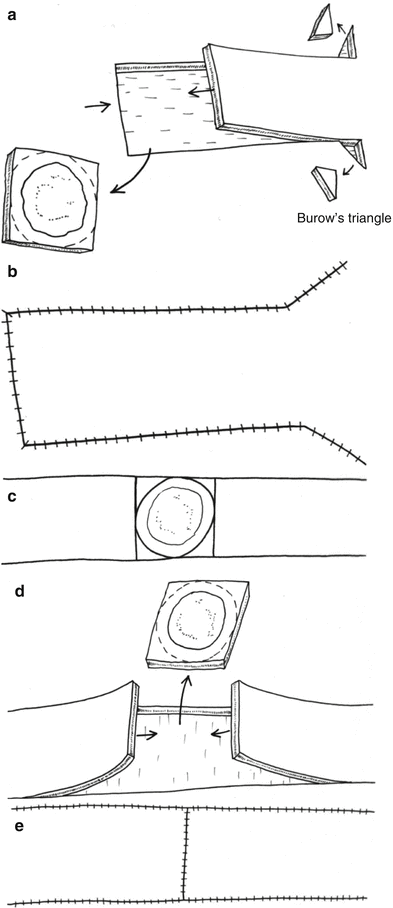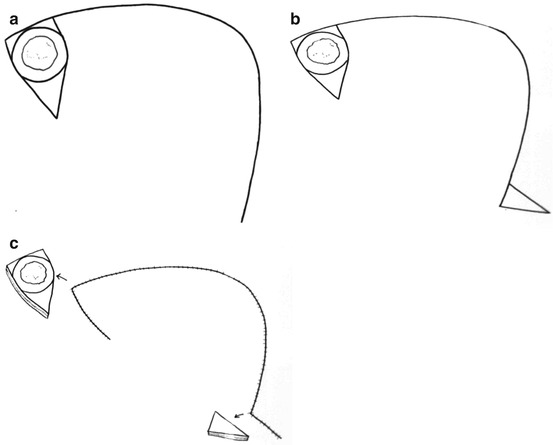, Madan Ethunandan2 and Tian Ee Seah3
(1)
Poole Hospital NHS Foundation Trust, Poole, Dorset, UK
(2)
Department of Oral and Maxillofacial Surgery, University Hospital Southampton NHS Trust Southampton General Hospital, Southampton, UK
(3)
Orange Aesthetics and Oral Maxillofacial Surgery, Singapore, Singapore
Advancement Flaps
These are flaps that are moved forward into the defect by primarily a sliding and stretching movement. One of the margins of the defect will form the leading edge of the flap. They are most useful where there is tissue laxity immediately adjacent to the defect. The most common types of advancement flaps are unilateral and bilateral advancement flaps, island advancement flaps and less common V-Y and Y-V advancement.
In unilateral and bilateral advancement flaps, two parallel incisions are made from the base of the defect, preferably along RSTLs. The surrounding tissues are widely undermined and the defect closed in layer (Fig. 3.1a, b). The defect is often modified to obtain parallel edges. The length of the defect to flap ratio is preferably restricted to 1:3, and it is vitally important to avoid tension during closure. A combination of a long thin flap closed under tension is a recipe for wound breakdown.


Fig. 3.1
Advancement flap
In the case of bilateral advancement flaps (Fig. 3.1c–e), one flap is first raised to assess the necessity and if required the dimensions of the second flap.
Tips
The margins of the flap and the adjacent tissue are of unequal length due to its design. In addition, the flap is often thinner. These have to be taken into account during closure, which can be accommodated by differential suturing and excision of Burow’s triangle. The location of Burow’s triangle can be placed anywhere along the margins for best placement of the scars.
The incisions, though often parallel, can diverge slightly to obtain a broader pedicle and more appropriate placement of the scars.
The primary defect is closed initially and the adjacent margins subsequently. It is often easier to place all the sutures along the advancing margins, prior to tying.
Rotation Flap
These are best suited for triangular defects or defects that could be converted into a triangle. They recruit tissue immediately adjacent to the defect and one of the borders of the defect also form the leading edge of the flap. The principal movements are lateral transposition and pivoting. Ideally, the width of the defect should be twice the height, and the length of the flap should be at least four times the width of the defect. It is often not necessary to extend the arc of rotation to more than 90° to the axis of the defect.
A curvilinear incision is made from the base of the defect and the tissues widely undermined and the wound closed in layers (Fig. 3.2a–c).
Tips
Differential suturing can accommodate the differing lengths of the adjacent wound edges. It often results in a dog-ear at the base. The dog-ears often flatten spontaneously, especially in the scalp, and any residual deformity can be corrected at a later date (after 6 weeks) if necessary. If corrected during the initial procedure, it should be designed outside the circumference of the flap, to avoid compromising its vascularity.

Fig. 3.2
Rotation flap
Transposition Flap
Transposition flaps can be used to reconstruct defects of various shapes. The principal movement is lateral, and the flap recruits tissue immediately adjacent to or distant to the defect. One of the margins of the defect will form one of the margins of the flap. This could be along most of the length of the flap or just the base, depending on whether the tissue is recruited immediately adjacent or distant (with intervening tissue) to the defect.
Stay updated, free articles. Join our Telegram channel

Full access? Get Clinical Tree








